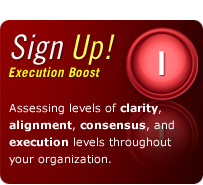Mission Activation: How to Actually Live Your Mission Statement (Even During Frantic & Uncertain Times)
December 31st, 2009
Many organizations, teams and individuals work very hard to develop mission, vision, and/or value statements — yet so many people that I speak with report that they often do not seem to “live” these statements extremely well. Each year, a lot of valuable time and energy goes into developing mission statements that will quickly be forgotten or ignored in the often frantic day-to-day activities that follow. And – here’s the kicker – many people seem to know that they will not fulfill their mission statements even as they spend valuable time developing them! And yet we continue to develop mission statements (both personal and professional) even as we recognize deep down that many of them will not be fulfilled very well. What is going on here – and how can we stop wasting valuable time, energy, and money developing statements that we know will not be fulfilled?
Motivation and Mission Statements. I believe that the first step in answering the important question above is to get to the bottom of the motivation for creating mission statements — and why that motivation for “Mission Creation” so rarely translates into “Mission Fulfillment.” Numerous scientific studies show that motivation is often associated with being aware of the rewards of doing something or the costs of failing to do it. The rewards of completing a mission statement are obvious and immediate; developing a mission statement is a great way to get fired up over what we would like to do in the future.
What is sometimes not as apparent (until it is too late) is the often huge price of failing to live our mission statements. From wasted money and time to decreased morale and increased cynicism, the effects of being out of alignment with our missions are far-reaching. For example, many believe that today’s economic situation is just one (major) example of the result of this misalignment. How can we stop wasting so much of our precious resources on unfulfilled mission statements? After years of research and countless conversations with my colleagues, clients, and other experts in the field, I believe we may have come to a very important answer to this critical question. The reason why so many mission statements often wind up wasting valuable resources is that most missions are not properly “activated.”
What is Mission Activation? An activated mission statement (personal and/or professional) is a statement that has been broken down into the key components that help ensure that day-to-day activity will be aligned with the statement — even during frantic and uncertain times (which are inevitable from time to time, as most people are well aware). Our experience and research over the past decade and a half have revealed some very simple and powerful steps that people can take in order to ensure that their mission statements will stay activated throughout the entire year. I’ve personally seen these steps help teams and individuals of all kinds become strongly aligned with their missions — with powerful, long-lasting, incredibly fulfilling results.
How Can You Activate your Mission? For those who would like to know more about mission activation, below are listed what we have found to be the 6 steps toward Mission Activation. As we were identifying these components, we realized that activating a mission was very similar to the process of growing a strong, solid, flexible tree. So, we came up with the term “Excellence Tree” to help get these ideas across; a well-maintained Excellence Tree results in an Activated Mission. The Mission Activation steps listed below include thoughts on how each step is related to growing an Excellence Tree:
- Check The Soil: Assess current levels of (and potential for) Mission Activation.
- Plant & Water Your Tree, Then Regularly Observe its Growth: Strongly align daily activity with the mission in clear ways. Then, promote execution by incorporating a communication technology that can allow all stakeholders to view progress in quick, easy ways.
- Identify & Pull Weeds: Identify barriers to Mission Activation – and quickly create SMART Solutions to overcome them.
- Prune Your Tree: Break “Mission-Deactivating Silos” by tracking (and rewarding) consensus and cooperation.
- Provide Adequate Sunlight: Implement a Mission Activation Reward System (a system that truly increases and maintains mission-aligned activity).
- Create Gardeners: Train others to help plant the tree, pull weeds, prune, and provide their own sunlight to the tree (the mission) across the entire year.
Click here for some brief descriptions of each Mission Activation step listed above, along with some pointers on how to implement them to activate your mission.
What is the Impact of an Activated Mission? Mission Activation takes time, energy, and focused attention. So why would busy people want to even consider doing this hard work (especially during these particularly tough times)? The short answer is that we have seen Mission Activation drastically change people’s businesses and lives (including our own) in tremendously positive ways! On the other hand, we have all seen (and felt) the incredibly negative effects of organizations and individuals that do not live their mission statements. In fact, many believe that these tough times can at least partially be described as a culmination of a lot of un-Activated Missions (more on that, later).
On the other hand, it has been our experience that the organizations, teams and individuals who commit to Mission Activation not only achieve their objectives in more quality ways, they also report feeling better about their lives as a whole. Another interesting effect of Mission Activation: many people associated with teams and individuals that have activated their mission statements tend to want stay with them for long periods of time. People often decline incentives like larger paychecks to continue to experience mission-aligned cultures (what I sometimes refer to as a “Cultures of Sanity”) in a world that can sometimes seem very frenzied, unfair and cynical (and often very scary). Finally, I think Mission Activation also helps more people “get it,” as my colleague John Spence says — or, to truly understand what it takes to be successful and fulfilled over the long haul. For more on “getting it,” click here.
If Mission Activation is So Great, Why Are So Few Missions Actually Activated? This is a great question — one that is constantly on my mind as I interact with thousands of people every year who are pursuing their personal and professional goals. This question interested me so much that it was actually the topic of both my Masters thesis and my doctoral dissertation while pursuing my Ph.D. What our research team found was that the difference between “doing” things that we know are good for us and simply “wishing” that we did these things often came down to 5 critical factors. Click here for more on why there is such a large gap between wishing and doing.
What is the Cost of NOT Activating a Mission? Very often, a non-activated Mission Statement results in what I call “Frenzied Leadership” – leadership (including self-leadership) that often creates confusion and anxiety. Non Activated missions have other ramifications beyond Frenzied Leadership – including cynicism about the statement and the organization, team or individual that developed it. Change management guru Rick Maurer (and his blog’s visitors) express this cynicism quite effectively in his article entitled “Empty Words and Mission Statements”.
Some Closing Thoughts on Mission Activation. At our firm, we have observed some very stunning results associated with Mission Activation, from increased productivity and enhanced morale to decreased anxiety and lower levels of disengagement. Unfortunately, we have also found that very few mission statements are actually activated — and the ramifications of this run broad and deep in our businesses, our society, and our individual lives. I’ve personally seen mission activation solve many of the largest business, social, and personal problems facing us at this critical point in all of our lives. I hope this article will encourage more leaders and individuals to consider Mission Activation as a strategy for business and personal success.
______________
If this article was helpful to you, please feel free to comment on it below or forward it to someone who you think might be interested in it. You may also wish to visit our site and read more about Excellence Trees. I look forward to hearing from you!
Article Filed under: 2. Mission Activation Tips,I. WATER (Team/Group Excellence)



3 Comments Add your own
1. Excellence Tree Journal Â&hellip | September 24th, 2008 at 4:45 pm
[…] To return to the original Mission Activation article, click here. […]
2. Brian Mistler | January 8th, 2009 at 6:59 am
Dr. Higley — I continue to be impressed with your writing. Thank you. It’s amazing to me that so much energy is spent developing Mission Statements that are never implemented. I think you put your finger on both the causes, the importance and centrality of motivation, the costs, and of course as always, the solutions! Thanks for posting this! Brilliant.
3. Excellence Tree Online Jo&hellip | February 20th, 2009 at 11:03 am
[…] To return to the original Mission Activation article, click here. […]
Trackback this post | Subscribe to comments RSS Feed
Leave a Comment
Some HTML allowed:
<a href="" title=""> <abbr title=""> <acronym title=""> <b> <blockquote cite=""> <cite> <code> <del datetime=""> <em> <i> <q cite=""> <s> <strike> <strong>